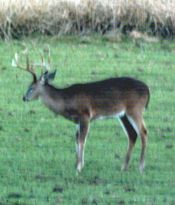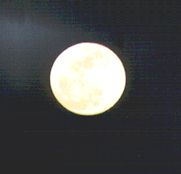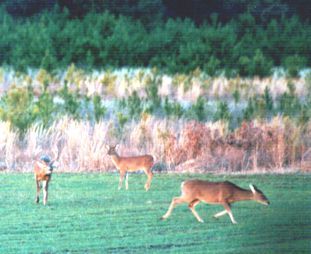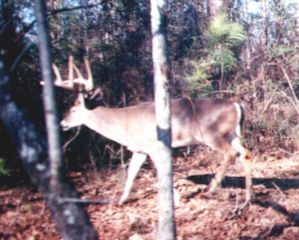
History of Deer Hunting in the Swamp
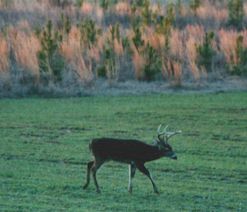
In the south-central section of Alabama, the Horn Swamp is blessed with quality herd of whitetail deer. In a horseshoe bend in the Alabama River, the Swamp provides many different habitats for deer. Young briar filled pine thickets , open fields, ten to twenty-five year old pine plantations, and old hardwood bottoms filled with great acorn producing trees all hold a good number of deer. A diversity of habitat is what makes the lands so popular for wildlife.
Twenty to twenty-five years ago the Swamp held a large number of big racked deer. 200 of the 1140 acres were farmed in corn, soybeans, and wheat. There was no shortage of food. The bucks grew fat and sported monster racks. But the farming came to an end in about 1987. The farmers who had for many years tilled the land went out of business. The deer herd had grown so large, even with hunting pressure, that the farmers could not afford to feed them. They were destroying the crops.
A few years before the farming ended, in an effort to thin the herd, the land was put on the State's new Deer Management Assistance Program (DMAP). The program allows the landowner to receive a certain number of doe tags that can be filled any time during the regular deer season. Weights are recorded and jawbones are pulled from each deer killed, bucks and does. The records are turned over to area biologists at the end of each season and they determine a recommended number of antlerless tags for the upcoming year, based on the condition of the herd.
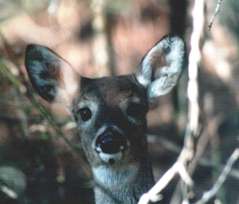
The program has been very successful in Alabama, where in the central portion of the state the herd had become too large. Beginning in 2000 the doe season was extended to "two does per day" or "a buck and a doe per day" on all lands in the southern portion of the state and we discontinued our participation in the DMAP while continuing with our same management goals.
Current State of Deer Hunting in the Swamp
The habitat continues to evolve in the Swamp as pines shade out the briar thickets that are important to the deer. From 1995 to 2002 the Swamp saw a great reduction in these briar thickets that provide cover and food for the deer. As a result the population of deer declined. Timber harvest and thinning since then has helped to revitalize the available browse and conditions have improved for year around food sources for the deer. The Swamp still possesses a good number of deer and we have seen a nice increase in the quality of bucks killed in recent years.
The buck/doe ratio appears to be in a good condition. We have learned much about the herd by using our motion-sensored camera that we have named the Swamp Sleuth. The camera has taken photos of numerous bucks that we never knew existed. We have gotten looks at many bucks that we had never seen while hunting and that are without doubt very nocturnal. At the present time the Swamp holds a good number of bucks in the 115-135 B&C class. Seeing these deer during the daylight continues to be a great challenge for hunters.
At the present time we maintain our goals of a buck harvest of 8 or less, concentrating on the mature animals of the 4½ to older age group. We are harvesting 8-10 does per season at this time.
Deer Season & Popular Methods of Hunting
Alabama's deer hunting season is the most liberal of anywhere in the world. Bowseason starts on Oct. 15th and lasts through Jan. 31st. Gun season begins on the Saturday before Thanksgiving and ends Jan. 31st. In 2007 the State of Alabama reduced the "buck a day limit" to 3 bucks, one of which much have at least 4 points on one side. The one doe per day limit remains intact.
Bowhunting is very popular now in the Swamp. We enjoy the challenge of hunting the deer at close range. Bowhunting can be very successful in years of average to better acorn crops. In years when there is no crop, hunting has been very tough.
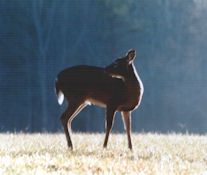
January brings the rut in our area, the best time to take a mature whitetail. The rut continues into February though the season is closed by then. Most of our fawns are born in August and September.
Of course there are plenty of hogs to distract any and all deer hunters. When a big hog passes through a deer hunters line of sight, he usually takes a good bit of lead or broadhead fire!
For more information on Alabama's deer herd, bag limits, and hunting seasons, see our HUNT ALABAMA page.
Our Management System
Estimates are that only 1 out of every million bucks killed qualify as a Boone & Crockett buck (over 170 on the B&C scoring method). We do not attempt to take only monster bucks.
Our philosophy is to take only a limited number of bucks (one per 100 acres). Of the bucks we do take, we attempt to harvest only the bucks that have reached an age of 4 1/2 or older. The majority of the mature whitetails that we kill are in the 4½ to 5½ year old range. Bucks older than 5 1/2 are very nocturnal and are very difficult to see.
We do not have specific rules to judge "shooter bucks" but by aging the jawbones and through many years of harvesting deer from this land we are able to tell which bucks fit these classifications. Many clubs have a "spread rule." Our deer don't typically have wide spreads (greater than 18"), therefore, we put more emphasis on the mass of a rack along with the length of the main beams in order to judge the age of a deer before it is harvested. Our typical "shooter buck" averages between 115 and 125 B&C points.
The harvesting of does is also vitally important to maintaining a well-balanced herd. Because many of the 1st year bucks have only "buttons" just above the hairline, they can easily be mistaken for a doe. These mistakes are costly in the attempt to limit the buck harvest. Therefore, we only encourage hunters that are experienced in distinguishing the difference between a young buck and a doe to assist in taking a doe.
Through a balanced harvest of the bucks and a continued emphasis on harvesting a portion of the the female population, we attempt to maintain a herd that us as hunters and our guests can enjoy.
After letting the young bucks walk, in order to actually see these deer at a later age, a limited amount of hunting pressure must be applied to the land. We have found that a 4 day absence of human scent in the area will greatly increase the movement of older bucks. Therefore, the Swamp is only hunted an average of 1½ days a week through the majority of the season.
Weather & Its Effect on Deer in the SouthOne of the most discussed topics during deer season is the weather forecast. The last decade has seen warming temperatures throughout the South.
During the fall and winter months we rely on the passing fronts to bring cooler and drier air. We believe the drier air behind a cold front has as much to do with increasing deer movement than does the cold weather, though the effects of the colder temperatures can not be downplayed.Typically, cold fronts can pass through as often as once per week. The days immediately preceding the front are often warm and humid and are the poorest days for deer movement. The days immediately after the front passes through are generally the best for deer movement.
Hunting during the "right" weather conditions is the final piece of the puzzle that must be in place to consistently harvest mature whitetails. No matter how many bucks there are on the property and regardless if the rut is occurring or not, warm weather will severely limit, if not prohibit, the sightings of deer in general in the Swamp and specifically the older bucks. There is no better time to hunt the Swamp than during the time a cold front is passing through, and immediately afterwards, provided that the land has experienced a rest from hunting pressure for a few days.
And lastly, what effect does the moon have on deer? For every hunter you ask you can get a different answer. Our opinion is that a bright moon is indeed a factor in increasing nighttime movement of deer which, in turn, decreases daytime movement. However, we still see many more deer on cold days after full moon night than warm days after dark nights.
For more on our harvest results, please see the HARVEST page.
Buck in Rut! Jan. 31, 2000!
A few of our pictures...
(Click to view, use BACK browser button to return!)Tommy Malone & a
big 8 from the Red Field!William Malone and a long tined
8-point from the Front Field.
Photo taken Feb. 2001 by the Swamp Sleuth
See the PHOTO ALBUM and the SWAMP SLEUTH page
for many more deer pictures!
Learn to age your deer at this link!
Horn Swamp Deer Harvest History_____________________________________________________________________________________
